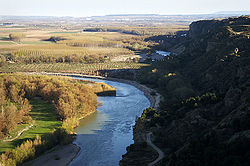
This is an incomplete list of rivers that are at least partially in Spain. The rivers flowing into the sea are sorted along the coast. Rivers flowing into other rivers are listed by the rivers they flow into. Rivers in the mainland Iberian Peninsula can be divided into those belonging to the Mediterranean watershed, those flowing into the Atlantic Ocean and those emptying into the Cantabrian sea (a marginal sea of the Atlantic off the northern coast of the Iberian peninsula).
Contents
- Mediterranean watershed
- Catalan basins
- Ebro
- Levante
- Andalusian Mediterranean basins
- Atlantic watershed
- Gulf of Cádiz
- Tagus
- Douro
- Lima
- Minho-Sil
- Rias Baixas and Rias Altas
- Cantabrian watershed
- See also
- References
- External links
Tributaries are listed down the page in an downstream direction. The main stem river of a catchment is labelled as ms, left-bank tributaries are indicated by l, right-bank tributaries by r. Where a named river derives from the confluence of two differently named rivers these are labelled as ls and rs for the left and right forks (the rivers on the left and right, relative to an observer facing downstream). The transboundary rivers partially running through Portugal or France and/or along the borders of Spain with those countries are labelled as int.
The list begins with the northernmost item of the Mediterranean watershed (close to the French border) and moves clockwise around the Iberian Peninsula.
Outside from the Iberian peninsula mainland, streams in the Canary Islands, the Balearic Islands, Ceuta and Melilla are seasonal watercourses. The Santa Eulàlia river in Ibiza was traditionally considered as the single proper 'river' in the Balearic Islands, but it lost its constant flow by the late 20th-century. [1]
















